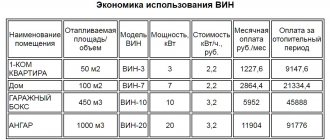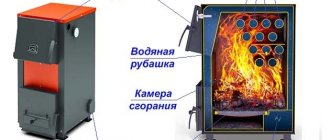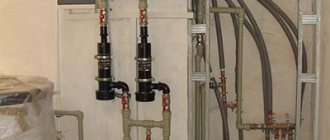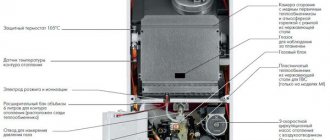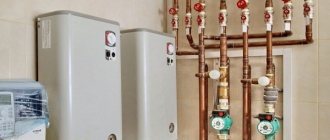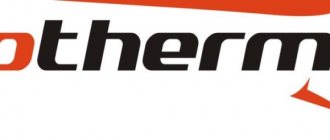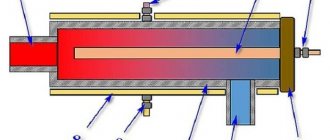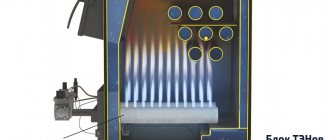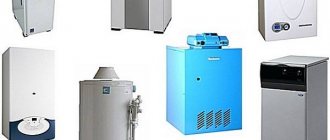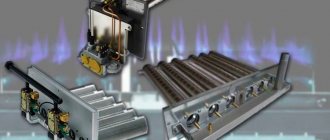Ecology of consumption. House: The phenomenon of electromagnetic induction consists in the creation of an induced current when exposed to an alternating magnetic field of a coil. The thermal effect of the resulting flow is used to heat the coolant
In conditions of the energy crisis and the constant increase in energy prices, we have to look for new opportunities for heating premises at minimal cost. Developed back in the mid-19th century and not widely used in everyday life, induction heating technology is becoming popular due to its efficiency and accessibility.
Heating principle
The phenomenon of electromagnetic induction is the creation of an induced current under the action of an alternating magnetic field of a coil. The thermal effect of the resulting flow is used to heat the coolant.
If an object made of an electrically conductive material is placed in a closed circuit (inductor) consisting of several turns and high-frequency currents are passed through it, an electromagnetic field is formed in the turns, creating eddy currents that heat the object located in them. The heating intensity is influenced by several parameters:
- as the magnetic field power increases, the heating force increases;
- dependence on the magnetic properties of the core;
- distance from the inductor to the object.
It is equally important to correctly select the operating frequency of the converter, which affects the depth of heat penetration into the core, that is, the point where the current density drops to 37%. This figure increases with frequency.
To use this phenomenon in practice, you need an installation consisting of a coil that creates an electromagnetic field and a heat exchange element that heats up under its action.
Further heat transfer is spent on increasing the temperature of the coolant.
Equipment using the principle of electromagnetic induction is widely used in the metallurgical industry in crucible furnaces, and is becoming increasingly popular in household appliances - kitchen induction cookers and heating boilers.
Working method and design of induction heater
Induction is a physical phenomenon that is based on eddy currents. They were discovered and studied by the French physicist Foucault. An induction electric boiler for heating uses in its operation Foucault currents, which work using the same electromagnetic induction method. An alternating voltage appears on the coil, creating a magnetic field, which causes the occurrence of eddy currents that heat the steel. Water is heated in a heat exchanger and, working in the system, heats the rooms in the cottage.
An induction electric boiler for heating a private house consists of the following parts:
- heat exchanger;
- glued box;
- inductors;
- control box;
- conductors;
- inlet and outlet pipes.
For the comfort of using the system, its design may contain additional parts. This type of boiler consists of an inductor coil, which is hidden in a small but very heavy iron alloy housing. Instead of a heat exchanger, some systems install a simple metal tube with a heat source. But the presence of a heat exchanger evades the heat transfer distance.
Such a system has a high level of reliability and stability, since the induction coil is firmly closed in a sealed housing without coming into contact with the coolant. The appearance of holes in the turns is impossible, since they are not wound very tightly, and in addition, they are coated with a special insulating agent. All this is packaged in a massive case, which allows for a long period of use. Manufacturers provide a guarantee of up to 10 years, but sellers claim that an electric boiler with an inductor can last 30 years without maintenance.
Connecting an induction electric boiler
Advantages and disadvantages of such equipment
When deciding on the type of heating devices, you first need to find their strengths and weaknesses. The obvious advantages of induction boilers include the following qualities:
Induction cooker
- High efficiency, reaching 98%;
- Reducing heating costs up to 30%;
- Equipment reliability due to the absence of heating elements;
- Increased degree of electrical and fire safety;
- Possibility of using any type of coolant;
- Large range of obtained parameters;
- No scale;
- Reliability and trouble-free operation for a long time.
The main disadvantages of such devices, limiting their use, have always been too high a price, large size and weight, as well as difficulty of adjustment. Recently, induction devices have become more compact, and they can be made accessible by DIY assembly.
Which heater is best to use?
The principle of induction heating has been used in industry for many years. Such devices are popular in steel production, in the manufacture of electric-welded pipes, for heat treatment, improvement and hardening of metals, and in welding machines. Recently, various models have been produced for domestic heating.
Water heating
Thanks to the intense heating of the coolant, it is possible to install flow-through equipment for hot water supply that uses the calorific value of induction forces.
Such a device consists of a transducer that creates a magnetic field and a pipe with water that acts as a core.
Heat in the heating system
Any electric boiler is the most environmentally friendly and convenient means of heating for a private home.
But the habitual use of heating elements leads to high operating costs, forcing us to look for alternative ways to generate heat. The situation will be corrected by an induction boiler, which has minimal electricity consumption.
By installing a fairly simple device, a vortex induction heater, on a water heating pipe, you can get the best option, combining small payments for fuel with efficient heating.
In principle, the design is identical to a water heater, only a pipe included in the heating circuit is used as the core. Induction heating boiler
The rate of heating of the coolant in VIN is significantly higher than in other electrical devices, and the entire area in contact with the device is heated, which allows for significant savings in resources.
Like all modern boilers, induction boilers are equipped with a pump, a sensor system and a control panel that allows you to select the required mode.
Space heating
Another simple and reliable heating method involves the use of two devices, an inductor and an induction cooker, connected to a battery. This design can be used in an operating system instead of a traditional boiler. The inverter creates a magnetic field that acts on the plate with a casing made of magnetic material installed on it. It is through this that the pipes are passed.
It is very important that the circuit is made of a non-magnetic material, otherwise eddy currents will spread throughout the system, which will negatively affect efficiency. For a small house, sufficient heating will be provided with a 2000 W induction hob.
Homemade heating
One of the latest developments is the use of an inverter from a welding machine for heating. Several turns of wire are wound onto the pipe, and copper shavings are placed inside. This entire structure is connected to a small inverter.
Design characteristics of two types of boilers
Before purchasing an induction electric boiler for autonomous heating at home, you need to understand which type of device is most optimal in your situation. There are two types of electric boilers based on eddy currents used to heat a heat source - SAV and VIN - they have characteristic differences from each other:
- The SAV electric boiler does not require an inverter for uninterrupted operation. In such a situation, the voltage from the network of 50 hertz goes directly to the coil. As a result, the secondary winding, which is contained in a system of metal pipes of the heat exchanger, is heated by Fuka currents, instantly heating the water. The coolant is forced to move along the circuit of the heating device using a circulation pump. SAV induction boilers are designed for voltages of 220V and 380V. The device, which has a power of 2.5 kW, heats a room up to 30 square meters. You can buy this equipment together with automation and control unit for 31 thousand rubles;
- induction electric heating boilers VIN. These models are improved, and their operation requires a special inverter that transforms the frequency of the electrical network. This technological solution makes it possible to produce lightweight structures. The heat exchanger is made of a ferromagnetic alloy, and the core and body of the equipment are the magnetic core and secondary winding. This boiler has a power of 3 kW and can easily heat a room of 40 square meters. A fully equipped VIN electric boiler will cost 40 thousand rubles.
We recommend: How does the Miratron induction heating boiler work?
What determines the efficiency of the system?
Costs when using induction boilers are 30% less than when heating with heating elements. This is primarily achieved due to the simplicity of the design and proper installation. An important factor is the fact that heating water in the circuit does not require heating of other elements, and the device itself is used as a heater.
With a reasonable choice of automation, you can adjust the boiler power depending on changes in external factors. The device should start at a reduced power, which will increase as it heats up.
For economical operation of the equipment, it is necessary that the elements included in the system meet certain requirements:
- any radiators except cast iron were used;
- the automation was modern and ensured accurate adjustment;
- installation was carried out in accordance with the instructions.
Installation of the device
To operate effectively, the induction boiler must be installed in a closed heating system, and it must be positioned strictly vertically. By connecting the input and output of the device to the circuit, and switching the flow of coolant through the installed device, you can obtain reliable and inexpensive heating. Moreover, any substance can be used as a working fluid:
- plain water;
- antifreeze;
- special antifreeze for heating systems.
The location of such a boiler deserves special attention. Do not mount the device closer than 30 cm to the wall and at a distance less than 80 cm from horizontal ceilings.
In addition, given the decent weight of the device, the wall must be strong enough, and the fasteners must be reliable.
Features of installing induction heaters
Induction electric heating systems should only be installed with a closed circuit with a membrane expansion tank and a circulation pump. Forced circulation is required primarily because intense heating and the small volume of the core prevent natural air exchange; water begins to boil immediately after creating conditions for gravitational circulation.
We recommend: Features of repair of heating boilers
If an induction heating electric boiler is used as a heat generator, then you need to use plastic pipelines in the circuit or separate the metal pipes from the boiler by installing plastic fittings. The boiler must be properly grounded. Installation requirements are the same as for all electric boilers: from the distance of the floor or ceiling - 80 cm, from the wall - 30 cm. Installation of a safety unit with a pressure gauge, air and safety valve is considered mandatory, as for all indoor heating systems. Cottages usually use a standard connection system.
Induction heater
Installation of induction heating systems must be carried out in accordance with the rules specified in the technical data sheet. The device must be in a vertical state, the lower input pipe is connected to the run-in, the upper one to the supply. For this, only metal or metal-plastic pipes should be used. If you decide to install the boiler yourself, do not forget about grounding. Nearby you need to install a control box security group, at the input - filters and a flow mechanism.
At the time of purchasing the system, check the operating power, which should not decrease during operation. The ideal option would be 60 W per 1 square meter. It is important to consider the size of all rooms. If you have poor thermal insulation, then you need to use a powerful heating boiler.
The latest models of systems can maintain low temperatures in rooms that are not often used. They are economical due to minimal system inertia, reliability, stability, and good automation. Such equipment is installed as additional equipment in cottages and for heating offices and retail areas.
YouTube responded with an error: The request cannot be completed because you have exceeded your quota.
- Related Posts
- How do central heating boilers work?
- Pros and cons of combined gas-electric heating boilers
- How to install an induction heating boiler?
- How do combined solid fuel heating boilers work?
- How does the Miratron induction heating boiler work?
- How to make a hydrogen heating boiler?
